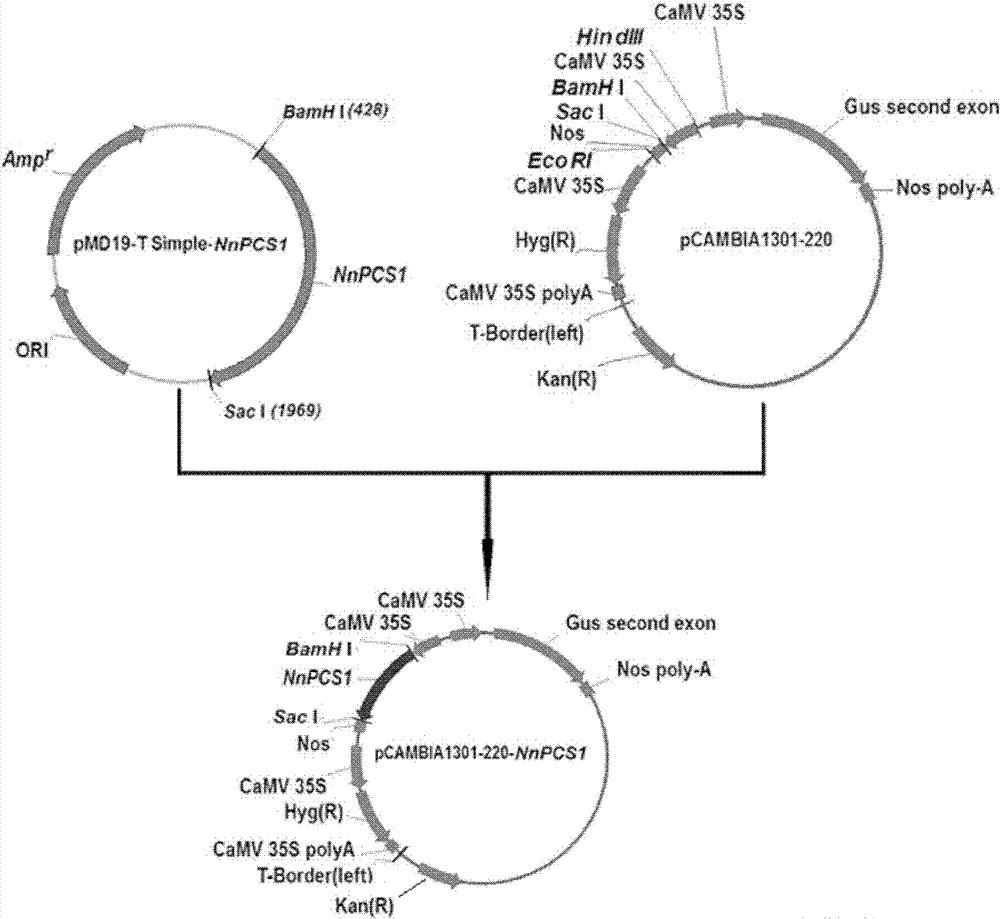Lotus phytochelatin synthase NnPCS1 and plant expression vector and construction method thereof
A plant expression vector and enzyme gene technology, applied in the field of lotus plant complexin synthase gene NnPCS1 and its plant expression vector and construction, to achieve the effect of improving heavy metal resistance and plant variety improvement
- Summary
- Abstract
- Description
- Claims
- Application Information
AI Technical Summary
Problems solved by technology
Method used
Image
Examples
Embodiment 1
[0032] The cloning of embodiment 1NnPCS1
[0033] The lotus variety ‘Donghe’ (Nelumbo nucifera Gaertn. ‘Donghe’) was selected as the material, and 400μMCdCl 2 Treat the 'Donghe' grown to 6 to 8 leaf stages, and take the young leaves after 3 hours, and extract the total RNA of the leaves according to the instructions of the Trizol RNA extraction kit (TaKaRa), and follow the M-MLV reverse transcription kit ( TaKaRa) 1 μg of total RNA was reverse-transcribed into cDNA.
[0034] Using the extracted leaf cDNA as a template, design primers NnPCS1-F and NnPCS1-R for PCR reaction:
[0035] Upstream primer NnPCS1-F: ATGGCGATGGCAGGTCTATACAGGC (SEQ ID NO.4)
[0036] Downstream primer NnPCS1-R: AGAGACTGAAGGTGTGCTGAGGCCA (SEQ ID NO.5)
[0037] 50 μL reaction system: 5.0 μL of 10×RCR Buffer, 1.0 μL each of NnPCS1-F and NnPCS1-R primers (20 μmol L -1 ), dNTP mix 4.0μL (2.5mmol·L -1 ), Taq DNA Polymerase 0.2μL, cDNA template 1μL, ddH 2 O 37.8 μL; reaction program: pre-denaturation at 95...
Embodiment 2
[0038] Example 2. Construction of plant expression vector pCAMBIA1301-220-NnPCS1
[0039]Design primers NnPCS1-ZF and NnPCS1-ZR for PCR reaction, introduce restriction sites BamHI and Sac I in the upstream and downstream of the target gene NnPCS1 respectively, connect the PCR product to the pMD19-T Simple vector, transform TOP10 competent cells, and extract positive Plasmid, BamHI and Sac I double-digested NnPCS1 fragment was ligated with BamHI and Sac I double-digested pCAMBIA1301-220, transformed, extracted positive, electrophoresis detected and sequenced to verify that it was SEQ ID NO.1. The specific steps were as follows:
[0040] Upstream primer NnPCS 1-ZF: CGCGGATCCATGGCGATGGCAGGTCTATACAGGC (SEQ ID NO.2)
[0041] Downstream primer NnPCS 1-ZR: CGAGCTCAGAGACTGAAGGTGTGCTGAGGCCA (SEQ ID NO.3)
[0042] ①Using the lotus leaf cDNA as a template, high-fidelity enzyme (PrimeSTAR TM HS DNA Polymerase, TaKaRa) for PCR reaction, 50 μL reaction system: 10×HS RCR Buffer 5.0 μL, Nn...
Embodiment 3
[0044] Example 3 Genetic transformation of Arabidopsis thaliana with plant expression vector pCAMBIA1301-220-NnPCS1 and identification of its resistance to heavy metals
[0045] ① Competent preparation and freeze-thaw transformation of Agrobacterium strain EHA105
[0046] Pick a single colony of EHA105 from the YEB (50ug / mL rifampicin) plate, inoculate it in 50mL YEB liquid medium containing 50ug / mL rifampicin, culture at 200rpm, 28°C until the OD value is 0.5, and then ice-bath the bacteria solution 30min, centrifuge to collect the bacteria, suspend in 2mL pre-cooled 100mM CaCl 2 (20% glycerol) solution, 200uL / tube aliquoted for use.
[0047] Take 10uL pCAMBIA1301-220-NnPCS1 vector plasmid, add 200uL EHA105 competent cells, ice bath for 30min, freeze in liquid nitrogen for 5min, 37°C for 5min, add 800uLYEB liquid medium, pre-culture at 28°C 200rpm for 4h, and smear the bacterial solution on YEB ( 50ug / mL rifampicin + 50ug / mL kanamycin) solid medium, cultured in the dark at ...
PUM
 Login to View More
Login to View More Abstract
Description
Claims
Application Information
 Login to View More
Login to View More - R&D
- Intellectual Property
- Life Sciences
- Materials
- Tech Scout
- Unparalleled Data Quality
- Higher Quality Content
- 60% Fewer Hallucinations
Browse by: Latest US Patents, China's latest patents, Technical Efficacy Thesaurus, Application Domain, Technology Topic, Popular Technical Reports.
© 2025 PatSnap. All rights reserved.Legal|Privacy policy|Modern Slavery Act Transparency Statement|Sitemap|About US| Contact US: help@patsnap.com



